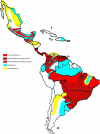Epidemiology of Invasive Fungal Infections in Latin America
- PMID: 22363832
- PMCID: PMC3277824
- DOI: 10.1007/s12281-011-0081-7
Epidemiology of Invasive Fungal Infections in Latin America
Abstract
The pathogenic role of invasive fungal infections (IFIs) has increased during the past two decades in Latin America and worldwide, and the number of patients at risk has risen dramatically. Working habits and leisure activities have also been a focus of attention by public health officials, as endemic mycoses have provoked a number of outbreaks. An extensive search of medical literature from Latin America suggests that the incidence of IFIs from both endemic and opportunistic fungi has increased. The increase in endemic mycoses is probably related to population changes (migration, tourism, and increased population growth), whereas the increase in opportunistic mycoses may be associated with the greater number of people at risk. In both cases, the early and appropriate use of diagnostic procedures has improved diagnosis and outcome.
Figures
References
-
- Colombo AL, Tobón A, Restrepo A, et al. Epidemiology of endemic systemic fungal infections in Latin America. Med Mycol. 2011;49(8):785–98. - PubMed
-
- Sánchez-Alemán MA. Histoplasmosis in travelers [Histoplasmosis del Viajero] Enf Inf Microbiol. 2009;29:111–116.
-
- Kontoyiannis DP, Marr KA, Park BJ, et al. Prospective surveillance for invasive fungal infections in hematopoietic stem cell transplant recipients, 2001–2006: Overview of the Transplant-Associated Infection Surveillance Network (TRANSNET) Database. Clin Infect Dis. 2010;50:1091–1100. doi: 10.1086/651263. - DOI - PubMed
LinkOut - more resources
Full Text Sources
Miscellaneous

